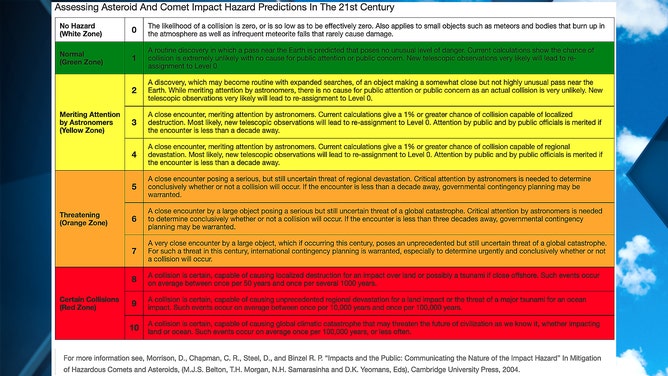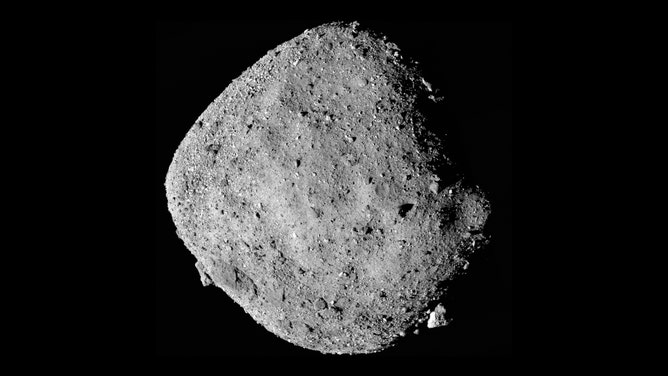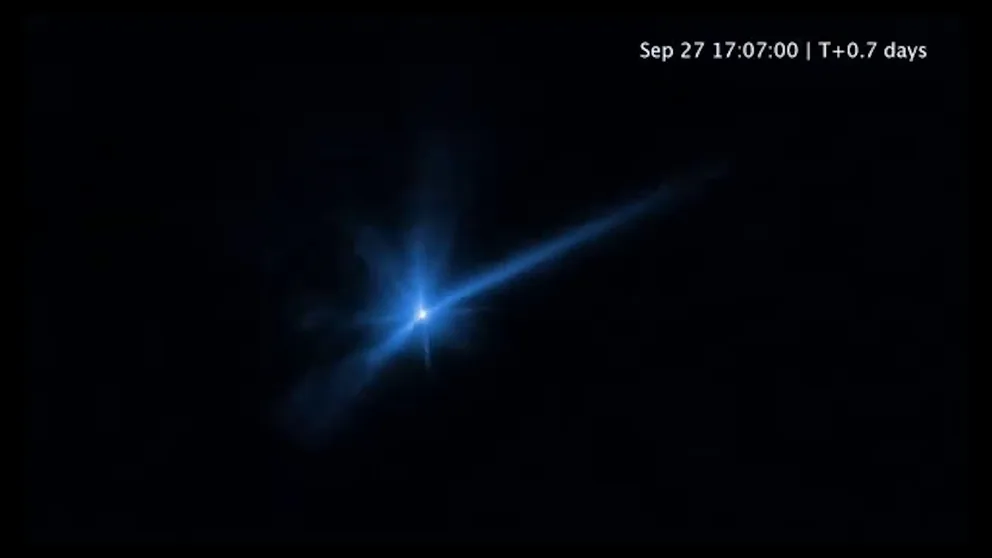What is the 'Torino Scale' when it comes to asteroid impact risk?
Astronomers use the Torino Scale, which gives a risk assessment from 0 to 10 of any asteroid determined to have an orbit that could bring it relatively near Earth or perhaps even strike someday.
Dinosaur-killing asteroid triggered a tsunami with mile-high waves
An asteroid that struck Earth 66 million years triggered a megatsunami that wiped many of the dinosaurs
There are scales for measuring hurricanes, tornadoes and earthquakes, but did you know there is also a scale for assessing the risk of any impeding asteroid collisions?
Asteroids harmlessly buzz by Earth (relatively speaking) all the time, such as the Eiffel-Tower-sized asteroid that passed within six moon lengths. But what if one appears as if it will get too close for comfort?
Astronomers use the Torino Scale, which gives a risk assessment from 0 to 10 of any asteroid determined to have an orbit that could bring it relatively near Earth or perhaps even strike someday.
A rating of 0 means the asteroid poses no threat to Earth, which, so far, is the rating for every near-Earth asteroid currently being tracked.
On the other hand, a rating of 10 would mean a global catastrophe is imminent. Each number in between covers scenarios from tiny asteroids making a calculated close pass with a greater than background chance of hitting Earth to large asteroids that make a near-miss.
Here is the scale (larger version can be found here):

The Torino Scale aims to rate the risk of any asteroid strike on Earth. (Larger version at: https://cneos.jpl.nasa.gov/sentry/torino_scale.html)
(JPL / NASA)
The original scale was developed by MIT professor Richard Binzel and adopted in 1999, but since revised in 2005 to better clarify that many asteroids eventually given an initial rating will likely later be deemed harmless.
When an asteroid is discovered, astronomers will initially only have rough calculations of its orbit with a wide range of paths – remember, we're dealing with a galactic scale of measurements on the order of millions of miles. Earth is only about 7,900 miles across.
"Often when new objects are first discovered, it takes several weeks of data to reduce the uncertainties and adequately predict their orbits years into the future," NASA wrote in a Tweet in March.
If some of those initial calculations indicate an asteroid could theoretically make an impact within its wide range of orbit possibilities, it could get assigned a number on the scale – most typically a 1. As more observations come in and the orbit becomes more refined, astronomers can confidently move the asteroid to a 0 rating.
EVERYTHING SCIENTISTS WOULD WANT TO KNOW IF AN ASTEROID WAS HEADING TOWARD EARTH
A recent example of this occurred in late February and March when astronomers discovered small asteroid 2023 DW, whose initial rough orbit calculations had a minuscule chance of hitting Earth on Valentine's Day in 2046. It was even given an investigatory rating of 1 on the Tornio Scale and made the news rounds.
By mid-March, further observations showed the asteroid had a near-zero chance, dropping it to a 0 Torino rating. A few days later, more observations confirmed what was "near zero" was now a "zero" chance, and the asteroid has since been removed from the Near Earth Object tracking database.
But even if an asteroid were to someday get a 2, 3 or 4 rating, it means astronomers believe it will eventually drop to 0.
Are there any threatening asteroids?
Of all the asteroids NASA has tracked, none warrant any current concern to Earth. However, two asteroids being tracked have not yet been assigned a 0 rating – or any rating – on the scale: 101955 Bennu and the extraordinary tale of asteroid 1950 DA.
Bennu, discovered in 1999 and about a half-kilometer wide, has some initial calculations that exhibit extremely low but non-zero probabilities of potential impacts in the late 22nd century. The chances of impact begin in the year 2178, with September 2182 having the "best" chance – though still currently at just 0.037% probability. Yet that is, as of early May, the asteroid with the greatest known probability of striking Earth someday, despite having such a small chance. It doesn't merit a rating because any impacts are more than a century in the future.

This mosaic image of asteroid Bennu is composed of 12 PolyCam images collected on Dec. 2 by the OSIRIS-REx spacecraft from a range of 15 miles (24 kilometers).
(NASA / Goddard / University of Arizona / NASA)
DINOSAUR-KILLING ASTEROID TRIGGERED A TSUNAMI WITH MILE-HIGH WAVES, NEW STUDY SAYS
1950 DA is 1.2 kilometers across and has one potential impact – in the year 2880. This is a rare feat that astronomers can calculate such an orbit some 850-plus years into the future because the asteroid was discovered in 1950, and astronomers have over 70 years and more than 900 observations to track and hone its orbit.
Earlier this century, observations showed the orbit of 1950 DA had the highest probability of significant impact of any asteroid they were tracking (though still very remote – about a 1-in-8,000 chance). However, newer observing technology has recently updated 1950 DA's orbit calculations that can put our distant future ancestors at ease – the risk level of a 2880 impact has dropped significantly and is now down to about a 1-in-29,000 chance (0.0029%). Again, there is no rating on the Torino Scale anyway because either way, there is obviously no concern for the planet for centuries.
What happens if they someday do find something that merits a high rating on the scale?
NASA has been busy lately building an asteroid planetary defense system just in case something concerning is discovered in the future. The agency took an important first step with a successful test of the DART Mission in October 2022 by smashing an appliance-sized spacecraft into a small asteroid that was orbiting another small asteroid about 7 million miles from Earth.
HOW NASA IS WORKING TO PROTECT EARTH FROM AN ASTEROID STRIKE
The impact made an ever-so-slight change in the orbit of the smaller asteroid. The hope is we could similarly force a tiny change in the orbit of any threatening asteroid that, when factored over an orbit of millions of miles, would be enough to nudge it out of a collision course. NASA and other space and government agencies also conduct annual exercises that practice what would be an appropriate response should an asteroid ever threaten the planet.
Watch: New video shows DART asteroid impact debris from Hubble space telescope
A video NASA released on Wednesday shows the debris caused by the Double Asteroid Redirection Test (DART) mission spacecraft slamming into the asteroid Dimorphos. (Courtesy: NASA / ESA / STScI / Jian-Yang Li (PSI) / Joseph DePasquale (STScI))
Meanwhile, NASA is always working to increase our celestial surveillance capabilities to find and track all objects that would aim to someday literally rock our world.

